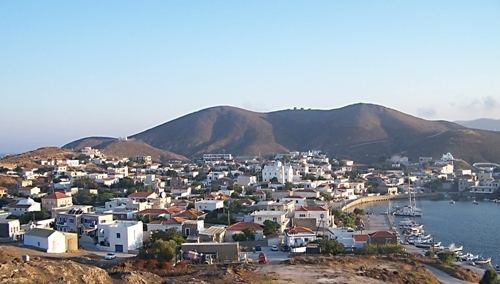Country Greece Lowest elevation 0 m (0 ft) Postal code 82x xx Elevation 531 m Area code 22740 | Highest elevation 512 m (1,680 ft) Time zone EET (UTC+2) Vehicle registration ΧΙ Area 44.51 km² | |
 | ||
Psara aegean sea hellas greece
Psara (Greek: Ψαρά, Psará, [psaˈra]; formerly known as Ψύρα, Psyra, or Ψυρίη, Psyriī) is a Greek island in the Aegean Sea. Together with the small island of Antipsara (Pop 4) it forms the municipality of Psara. It is part of the Chios regional unit, which is part of the North Aegean region. The only town of the island and seat of the municipality is also called Psara.
Contents
- Psara aegean sea hellas greece
- Map of Psara Greece
- Geography
- Flag
- History
- Destruction of Psara
- Notable people
- References
Map of Psara, Greece
Psara had 448 inhabitants according to the 2011 census. It has a small port linking to the island of Chios and other parts of Greece.
Geography
Psara lies 44 nautical miles (81 km) northwest of Chios, 22 km (14 miles) from the northwestern point of the island of Chios and 150 km (93 mi) eastnortheast of Athens. The length and width are about 7 by 8 km (4 by 5 mi) and the area of the island is 43 square kilometres (17 sq mi). The highest point of the island is "Profitis Ilias" (512 metres (1,680 feet)). The municipality has an area of 44.511 km2.
Flag
The flag of Psara was designed by the Psariots and bears symbols of Filiki Eteria. It is made of white cloth bordered with red with a large red cross and the inscriptions of the name of the island "ΨΑ-ΡΑ" and the words Eleftheria i Thanatos (Liberty or Death) in capital red letters. The cross is standing on an upside down crescent, flanked on one side by a sword, on the other by a serpent killed by a bird. The flag was carried during the War of Independence by Psariot ships
An original flag of Psara, is preserved at the National Historical Museum of Greece
History
It has been inhabited since the Mycenaean period, its inhabitants relying on the sea to make a living as the island is treeless and rocky with little shrubbery. Homer first referred to the island as Psyra.
The islanders' sole source of livelihood has always been fishing, mainly for the locally abundant slipper lobsters, and shipping, with some tourist development in recent years.
Destruction of Psara
Psara joined the Greek War of Independence on April 10, 1821. A noted native naval leader of the time was future Prime Minister of Greece Constantine Kanaris and Dimitrios Papanikolis. The island was invaded on June 21, 1824 by the Ottoman navy.
On July 4 the resistance of the Psariots ended with a last stand at the town's old fort of Palaiokastro (alternative name Mavri Rachi, literally "black ridge"). Hundreds of soldiers and also women and children had taken refuge there when a Turkish force of 2000 stormed the fort. The refugees first threw a white flag with the words "Ἐλευθερία ἤ Θάνατος" ("Eleftheria i Thanatos", "Freedom or Death"). Then, the moment the Turks entered the fort, the local Antonios Vratsanos lit a fuse to the gunpowder stock, in an explosion that killed the town's inhabitants along with their enemies — thus remaining faithful to their flag to their death. A French officer who heard and saw the explosion compared it to a volcanic eruption of Vesuvius.
A part of the population managed to flee the island, but those who did not were either sold into slavery or killed. As a result of the invasion, thousands of Greeks have met a tragic fate. The island was deserted and surviving islanders were scattered through what is now Southern Greece. Theophilos Kairis, a priest and scholar, took on many of the orphaned children and developed the famous school the Orphanotropheio of Theophilos Kairis. Psara remained in the hands of the Ottomans until it was recaptured by the Greek navy on 21 October 1912 during the First Balkan War.
The destruction of Psara by the Ottoman Turks was conducted in retaliation for blowing up the ship of a Turkish Admiral by the revolutionary Dimitrios Papanikolis (who was from Psara). It inspired the poet Andreas Kalvos to write the ode "To Psara" (Greek: "Εἰς Ψαρά"); perhaps more famously, the event also inspired the poet Dionysios Solomos — the author of the Hymn to Liberty — to write in 1825 a poem (or epigram) about it called "The Destruction of Psara" (Greek: "Ἡ καταστροφὴ τῶν Ψαρῶν"):
